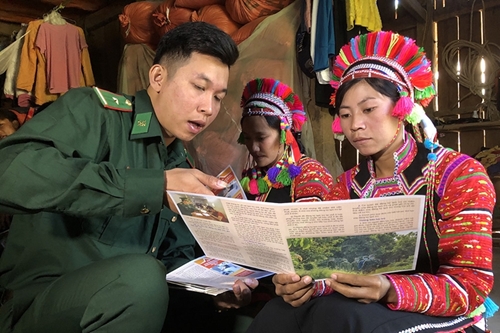A source of strength amidst hardships
Since moving into her new house, Hien Thi Co in hamlet 49A in Dak Pring commune, Da Nang City, has felt a renewed sense of hope and vitality. Reflecting on her journey, Co said, “We had long dreamed of a sturdy house to ease our hardships, but it wasn’t until 2023 were we able to make it a reality. With the support of VND 80 million from Nam Giang district Women’s Union Organization (before its administrative restructuring on June 30) and the dedicated officers and soldiers of the Quang Nam Provincial Border Guard (now under the Da Nang municipal Military Command), my husband and I found the motivation to build a new home through the 'Supporting women in border areas' program."
    |
 |
|
An officer of Pa U Border Post of Lai Chau province disseminating law to La Hu people in Tan Bien hamlet |
In addition to providing stable housing, the program has presented women with livestock, seedlings, and equipped them with farming and animal husbandry techniques. Quang Thi Ha from Que Phong commune, Nghe An Province is one of the women benefiting from the program. With a modest grant of VND 7 million and a breeding cow, her family began raising livestock and expanding their production. Over time, they not only have achieved financial independence, but can also pay for their children's education and build a solid home in the remote border area.
With the support of the program, thousands of women in border areas, like Co and Ha, have found renewed motivation and confidence to change their lives. According to President of the Vietnam Women’s Union Nguyen Thi Tuyen, the goal of the 2021–2025 phase is promoting sustainable livelihood support based on the principle of “teaching people to fish rather than giving them fish.” To that end, the Women’s Union organizations at all levels have worked closely with border guard units to develop livelihood models that leverage the unique strengths of each locality.
Five years, remarkable numbers
At the recent conference to review the program in the 2021–2025 period, delegates evaluated that over the past five years, over 1,022 practical and sustainable livelihood models have been implemented across the country. Notably, outstanding models, such as “Ethnic Minority Women’s Cooperative Groups for Ginseng Cultivation,” “Ra Du Rice Cultivation,” “Credit and Savings Models,” “Women’s Economic Development Groups,” “Women’s Start-up Initiatives,” “Livelihood Orchards,” “Cow Banks,” and “Rice Jars of Compassion,” continue to operate effectively in various border provinces.
Through these initiatives, more than 34,000 livestock and over 51,000 seedlings have been distributed; 19,154 women have received loans; and more than 21,900 women have participated in 670 vocational training courses and job programs.
Commenting on the program’s impact, Vice President of the Vietnam Women’s Union Nguyen Thi Minh Huong said that one of the program’s most significant achievements is its success in mobilizing social resources to provide direct and sustainable support for women in border regions. As of mid-2025, the total value of mobilized resources had surpassed VND 294 billion, beyond initial expectations, demonstrating the program’s strong resonance and influence across society. She also noted that 28 out of the 100 most disadvantaged communes have met the criteria for new-style rural areas, and the achievement partly came from the program.
To ensure the program’s long-term sustainability in the 2026–2030 period, there is the need to expand successful livelihood models, continue to organize training courses, and enhance engagement from various sectors, agencies, and enterprises to boost resources. It is said that the Vietnam Women’s Union should also focus on strengthening its grassroots-level organization, improving skills in management, legal education, and membership governance for local union leaders. In addition, women’s associations and border posts in needy localities in border areas and on islands should foster twinning relations.
Translated by Tran Hoai